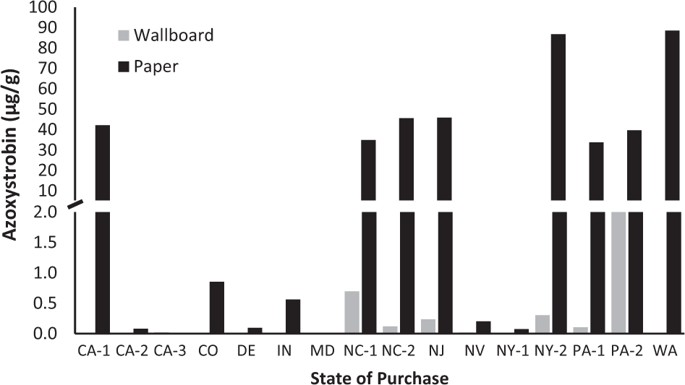当前位置:
X-MOL 学术
›
J. Expo. Sci. Environ. Epid.
›
论文详情
Our official English website, www.x-mol.net, welcomes your
feedback! (Note: you will need to create a separate account there.)
Strobilurin fungicides in house dust: is wallboard a source?
Journal of Exposure Science and Environmental Epidemiology ( IF 4.1 ) Pub Date : 2019-10-21 , DOI: 10.1038/s41370-019-0180-z Ellen M Cooper 1 , Rosie Rushing 2 , Kate Hoffman 1 , Allison L Phillips 1 , Stephanie C Hammel 1 , Mark J Zylka 3 , Heather M Stapleton 1
Journal of Exposure Science and Environmental Epidemiology ( IF 4.1 ) Pub Date : 2019-10-21 , DOI: 10.1038/s41370-019-0180-z Ellen M Cooper 1 , Rosie Rushing 2 , Kate Hoffman 1 , Allison L Phillips 1 , Stephanie C Hammel 1 , Mark J Zylka 3 , Heather M Stapleton 1
Affiliation

|
Strobilurin fungicides are used primarily in fruits and vegetables, but recently, a patent was issued for one strobilurin fungicide, azoxystrobin, in mold-resistant wallboard. This raises concerns about the potential presence of these chemicals in house dust and potential exposure indoors, particularly in young children. Furthermore, recent toxicological studies have suggested that strobilurins may cause neurotoxicity. Currently, it is not clear whether or not azoxystrobin applications in wallboard lead to exposures in the indoor environments. The purpose of this study was to determine if azoxystrobin, and related strobilurins, could be detected in house dust. We also sought to characterize the concentrations of azoxystrobin in new wallboard samples. To support this study, we collected and analyzed 16 new dry wall samples intentionally marketed for use in bathrooms to inhibit mold. We then analyzed 188 house dust samples collected from North Carolina homes in 2014-2016 for azoxystrobin and related strobilurins, including pyraclostrobin, trifloxystrobin, and fluoxastrobin using liquid chromatography tandem mass spectrometry. Detection frequencies for azoxystrobin, pyraclostrobin, trifloxystrobin, and fluoxastrobin ranged from 34-87%, with azoxystrobin being detected most frequently and at the highest concentrations (geometric mean = 3.5 ng/g; maximum = 10,590 ng/g). Azoxystrobin was also detected in mold-resistant wallboard samples, primarily in the paper covering where it was found at concentrations up to 88.5 µg/g. Cumulatively, these results suggest that fungicides present in wallboard may be migrating to the indoor environment, leading to exposure in the residences that would constitute a separate exposure pathway independent of dietary exposures.
中文翻译:

室内灰尘中的嗜球果伞菌素杀菌剂:墙板是一种来源吗?
球果霉素的杀菌剂主要用于水果和蔬菜中,但是最近,一种耐霉菌的壁板中的一种球果霉素的杀菌剂,天青霉素(Azoxystrobin)获得了专利。这引起人们对这些化学物质可能存在于房屋灰尘中以及室内潜在暴露的担忧,特别是在年幼的儿童中。此外,最近的毒理学研究表明,嗜球果伞素可能引起神经毒性。目前,尚不清楚墙板中的嘧菌酯应用是否会导致室内环境中的暴露。这项研究的目的是确定是否可以在室内灰尘中检测到嘧菌酯和相关的嗜球果伞素。我们还试图表征新墙板样品中嘧菌酯的浓度。为了支持这项研究,我们收集并分析了有意销售用于浴室中抑制霉菌的16种新干墙样品。然后,我们使用液相色谱串联质谱法分析了2014年至2016年从北卡罗来纳州房屋中收集的188份房屋灰尘样品中的嘧菌酯和相关嗜球果素,包括吡咯菌酯,三氟精胺和氟草酸酯。嘧菌酯,吡咯菌酯,三氟嘧菌酯和氟草酸酯的检测频率范围为34-87%,其中最常见且浓度最高的是嘧菌酯(几何平均值= 3.5 ng / g;最大值= 10,590 ng / g)。在耐霉菌的墙板样品中,主要是在纸覆盖物中也检测到了天青霉素,发现其浓度高达88.5 µg / g。累计
更新日期:2019-10-21
中文翻译:

室内灰尘中的嗜球果伞菌素杀菌剂:墙板是一种来源吗?
球果霉素的杀菌剂主要用于水果和蔬菜中,但是最近,一种耐霉菌的壁板中的一种球果霉素的杀菌剂,天青霉素(Azoxystrobin)获得了专利。这引起人们对这些化学物质可能存在于房屋灰尘中以及室内潜在暴露的担忧,特别是在年幼的儿童中。此外,最近的毒理学研究表明,嗜球果伞素可能引起神经毒性。目前,尚不清楚墙板中的嘧菌酯应用是否会导致室内环境中的暴露。这项研究的目的是确定是否可以在室内灰尘中检测到嘧菌酯和相关的嗜球果伞素。我们还试图表征新墙板样品中嘧菌酯的浓度。为了支持这项研究,我们收集并分析了有意销售用于浴室中抑制霉菌的16种新干墙样品。然后,我们使用液相色谱串联质谱法分析了2014年至2016年从北卡罗来纳州房屋中收集的188份房屋灰尘样品中的嘧菌酯和相关嗜球果素,包括吡咯菌酯,三氟精胺和氟草酸酯。嘧菌酯,吡咯菌酯,三氟嘧菌酯和氟草酸酯的检测频率范围为34-87%,其中最常见且浓度最高的是嘧菌酯(几何平均值= 3.5 ng / g;最大值= 10,590 ng / g)。在耐霉菌的墙板样品中,主要是在纸覆盖物中也检测到了天青霉素,发现其浓度高达88.5 µg / g。累计











































 京公网安备 11010802027423号
京公网安备 11010802027423号